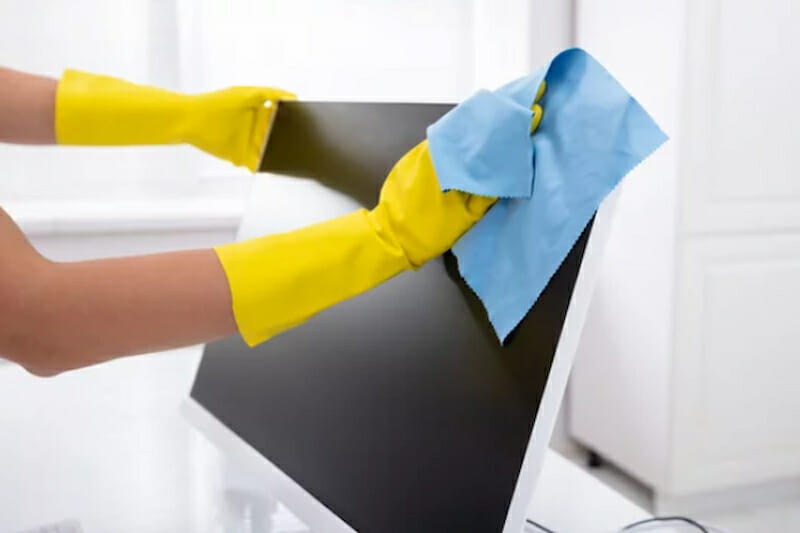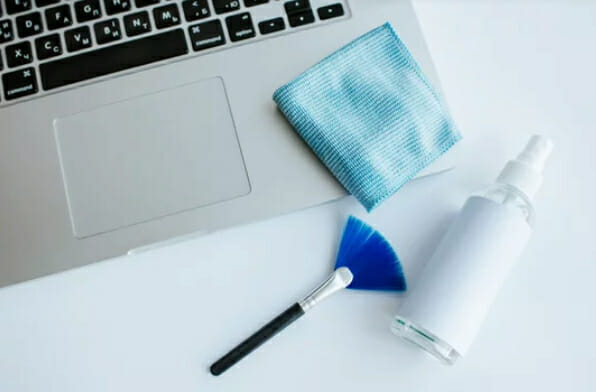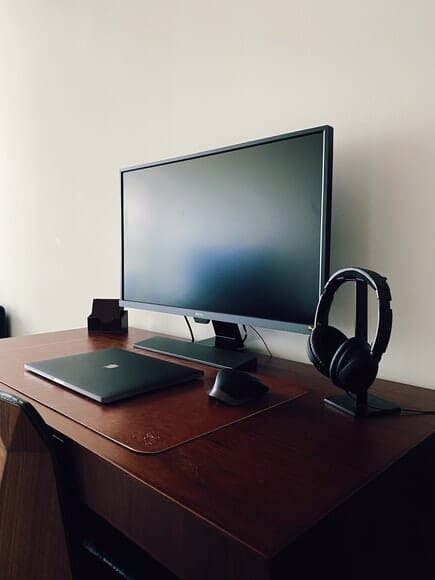Table of Contents
If you are not working on your monitor, you are probably using it for entertainment.
You have probably had a meal or two close to the computer or scratched your head and touched the keyboard. On that account, you will find fingerprint smudges, nail polish, food crumbs, ketchup, makeup; you name it. Besides, the static charges on the PC monitors attract dust, which can accumulate quickly.
If you want to get some work done, you need a tidy workspace. And having a clean screen may be just what you need to get your focus going.
However, using the wrong method to clean will cause more harm than good. So, what’s the right way to do it? Keep reading to learn more.
How to Safely Clean Your TV or PC Monitors
You want a PC monitor screen that's almost as spotless as it looked when you bought it. But, you just might be damaging your device’s screen by using the wrong screen cleaner.
Before you start cleaning using the tips below, check the manufacturer’s instructions on cleaning.

Turn Off Your Device
Before you start cleaning, switch off your device so that you can see the dust or smudges better. Also, you want to avoid any accidents if you have to use a liquid that might slip through.
Use a Microfiber Cloth
Microfiber cloths are great for cleaning electronics because they attract and hold dust and germs. They also clean up some smudges.
Wipe from side to side or top to bottom with broad strokes while screen cleaning. If there are any large particles, tap them off with the cleaning cloth first. You do not want to drag them across the display and leave scratches.
Use the cloth for cleaning your devices only to avoid transferring dirt from other surfaces.
Use Filtered Water
If the microfiber cloth does not remove all the gunk stuck on the PC or LCD monitor, you can use distilled water. Apply a small amount of water on the material and wipe off the stubborn grime using a spray bottle. Go over the surfaces with a dry cloth to remove any excess moisture.
Tap water has minerals that can damage your screen, so it is advisable to use the filtered one.
Also, putting too much-distilled water puts your appliance at risk of damage because it will sip through. You want to spray water on the cloth to make it damp.
Add Dish Detergent and Vinegar
Some stubborn stains, such as an oil-based stain, won’t come out with the fiber cloth or filtered water. In this case, you can add a drop of dish soap or vinegar to the distilled water, and it will help remove the stains.
Go over the areas with a dry cloth after you are done.
Use a Gas Duster and Vacuum Cleaner
Another tool to remove dust from your computer is compressed air. It is efficient with the least amount of effort. Here are the parts that a gas duster is most handy:
- Keyboard
Your keyboard is probably the dirtiest part of your monitor. It comes into direct contact with your fingers and food crumbs from what you might eat near it. Thus, you cannot skip it when you clean your computer.
The keyboard is one of the trickiest sections to clean. You can use a toothbrush to loosen the dirt stuck between the keys, then wipe them away with a soft microfiber cloth.
You can also use an air compressor to blow out the debris. However, be careful not to push the particles back to the keys or deeper. Try to do this at a 75° angle. If you do not have a gas duster, you can use a blow dryer. Make sure to set it in cold air.
- CPU
Besides using canned air, you can also use a vacuum cleaner or 0.4L bulb syringe to blow out dust. Cleaning this area is essential, especially the PC fans, because they help cool the monitor.
What Should You Avoid When Cleaning?
Electronics do not come cheap, and as much as you always want to keep them clean, you have to be careful.
Here are some things you should not do when cleaning them:
Spraying Any Cleaning Fluid Directly on the Device
A liquid cleaning solution can cause electrical damage to your device when the current passes through and meets it, causing a short.
Using Harsh Chemicals
Some of these include: cleaning products with alcohol, ammonia, and acetone, window cleaners, bleach, and wax. Using a harsh cleaning solution will cause damage to the protective coating on your display surface.
Wiping With Paper Towels
It is tempting to grab a paper towel off anything on a surface. However, you do not want to use it to clean your device’s screen. Serviettes are a bit rough and can leave scratches.
Applying Too Much Pressure
Gently wipe your screen, applying as little pressure as you can. Otherwise, you will damage your screen.
Using A Rough Cloth
A fabric might feel soft in your hand but can have tiny abrasive parts that scratch your screen. Do not fall into the temptation of grabbing t-shirts or bath towels to clean off.

How Often Should You Clean Your Monitor?
Sparingly clean the screen to avoid a lot of scratching. We recommend you do this every three to six months. However, you should often dust the other parts of the monitor to avoid dust clogging up.
Dust accumulation, especially on the fan, can cause overheating, which is unsuitable for the monitor’s functioning.
3 Tips on How to Maintain Clean Monitors
- Try not to eat close to your monitor
Most of the mess comes from food because you use your device most hours when you are awake. Therefore, you will find yourself grabbing a snack whose oil will end up on your computer monitor through your fingers. Or you grab a carbonated drink that spatters on the display when opening it.
- Sneeze and cough away from the monitor
A sneeze might sneak up on you but try to turn away from the computer monitor. Do so when coughing and blowing your nose to avoid covering your device with mucus or saliva.
- Avoid touching the screen unless it is a touch screen. It will reduce fingerprints and oil-based smudges.

Does Cleaning Your Monitor Have Benefits?
Yes, there are advantages for cleaning your monitors, and they include the following:
- Smooth running- Without the fun clogging up with dust, you will not have any problems with how your device works. It will also lengthen its life because it is not overworked while cooling off.
- Clear view- Stains on the monitor, especially the display, are a distraction; you cannot focus on your work. While you scroll down a document, all your eyes will be seeing is the spot on the screen.
- Health benefits- If there is dust on your monitor, it is highly likely to breathe in, which is unhealthy. Considering the hours you spend on it, you might end up with a cough, eye and nose irritation, or sneezing.
How to Fix Scratches on Your Device
If you had cleaned your monitor before finding this article, you might have ended with a scratch or two on your monitor. The good news is that you can do a few things to fix it.
The first step is to contact the manufacturer and determine if your warranty is valid. If it is, they will replace the screen.
You can also consult a professional to replace the screen and save time doing it yourself. It also reduces the chances of making the situation worse.

There are also some ways you can fix the screen yourself. However, these should be your last course of action, and make sure to practice caution.
Use Toothpaste
Apply a tiny amount of toothpaste on the scratch and spread it out with your finder. Go ahead and wipe the area with a microfiber cloth to remove the excess. Once dry, dampen the cloth and clean the screen.
Apply Petroleum Jelly
Petroleum jelly won’t fix the screen but will make it less visible and distracting. It also only works for matte ones. Apply a small amount on the scratch, spread it out, and wipe the excess with a microfiber cloth.
Use a Pencil Eraser
An eraser will work on a light scratch. Get rubber-like ones, not the rough ones, and rub them on the scratch.
Get a Repair Kit
You can buy a screen repair kit and follow the instructions provided in the user manual.

